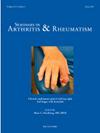巨细胞动脉炎患者复发症状的一致性
IF 4.4
2区 医学
Q1 RHEUMATOLOGY
引用次数: 0
摘要
目的探讨巨细胞动脉炎(GCA)患者首发、首次复发和第二次复发症状的一致性。方法:我们分析了三个GCA队列:286例活检证实的未使用托珠单抗的队列(C1), 110例活检阴性的未使用托珠单抗的队列(C2), 114例活检或成像证实的使用托珠单抗的队列(C3),以及这三个队列的总和(C4)。我们计算比值比和条件概率来评估从基线表现特征到第一次复发、基线表现到第二次复发、第一次复发到第二次复发的症状的一致性。结果该研究共纳入510例诊断为GCA的C4患者,随访时间中位数为5.3年(四分位数间范围:3.1-8.7年)。总体而言,303例患者至少有一次复发(5年首次复发率66%;95%可信区间[CI]: 60-70%), 160例患者至少有2次复发(5年第二次复发率:36%;95% CI: 31-41%)。大约20%的患者复发时症状类别在基线时不存在。基线大血管(LV)受累在第一次和第二次复发时提供了更高的LV受累风险。第一次或第二次复发时视觉症状的风险高,如果在前一阶段存在,但如果在前一阶段没有颅内或视觉症状,则风险低。结论患者和医护人员应了解GCA的症状谱,甚至在患者最初就诊时也应了解这些症状。本文章由计算机程序翻译,如有差异,请以英文原文为准。
Concordance of relapse symptoms in patients with giant cell arteritis
Objective
To evaluate concordance of symptoms between initial presentation, first relapse, and second relapse in patients with giant cell arteritis (GCA).
Methods
We analyzed three GCA cohorts: a 286-patient biopsy-proven cohort treated without tocilizumab (C1), a 110-patient biopsy-negative cohort treated without tocilizumab (C2), a 114-patient biopsy- or imaging-proven cohort that was treated with tocilizumab (C3), and an aggregate of these three cohorts (C4). We calculated odds ratios and conditional probabilities to evaluate concordance of symptoms from baseline presentation features to first relapse, baseline presentation to second relapse, and first relapse to second relapse.
Results
The study included a total of 510 patients (C4) diagnosed with GCA who were followed for a median of 5.3 (inter-quartile range: 3.1–8.7) years. Overall, 303 patients experienced at least 1 relapse (5-year first relapse rate 66%; 95% confidence interval [CI]: 60–70%) and 160 experiencing at least 2 relapses (5-year second relapse rate: 36%; 95% CI: 31–41%). Approximately 20% of patients relapsed with a symptom category that was absent at baseline. Baseline large vessel (LV) involvement provided higher risk of LV involvement on first and second relapse. Risk of visual symptoms on either first or second relapse was high if present at a previous stage, but low if either cranial or visual symptoms were absent at a previous stage.
Conclusion
Patients and providers should be educated on the spectrum of GCA symptoms to be aware of, even beyond those present at a patient’s initial presentation.
求助全文
通过发布文献求助,成功后即可免费获取论文全文。
去求助
来源期刊
CiteScore
9.20
自引率
4.00%
发文量
176
审稿时长
46 days
期刊介绍:
Seminars in Arthritis and Rheumatism provides access to the highest-quality clinical, therapeutic and translational research about arthritis, rheumatology and musculoskeletal disorders that affect the joints and connective tissue. Each bimonthly issue includes articles giving you the latest diagnostic criteria, consensus statements, systematic reviews and meta-analyses as well as clinical and translational research studies. Read this journal for the latest groundbreaking research and to gain insights from scientists and clinicians on the management and treatment of musculoskeletal and autoimmune rheumatologic diseases. The journal is of interest to rheumatologists, orthopedic surgeons, internal medicine physicians, immunologists and specialists in bone and mineral metabolism.

 求助内容:
求助内容: 应助结果提醒方式:
应助结果提醒方式:


